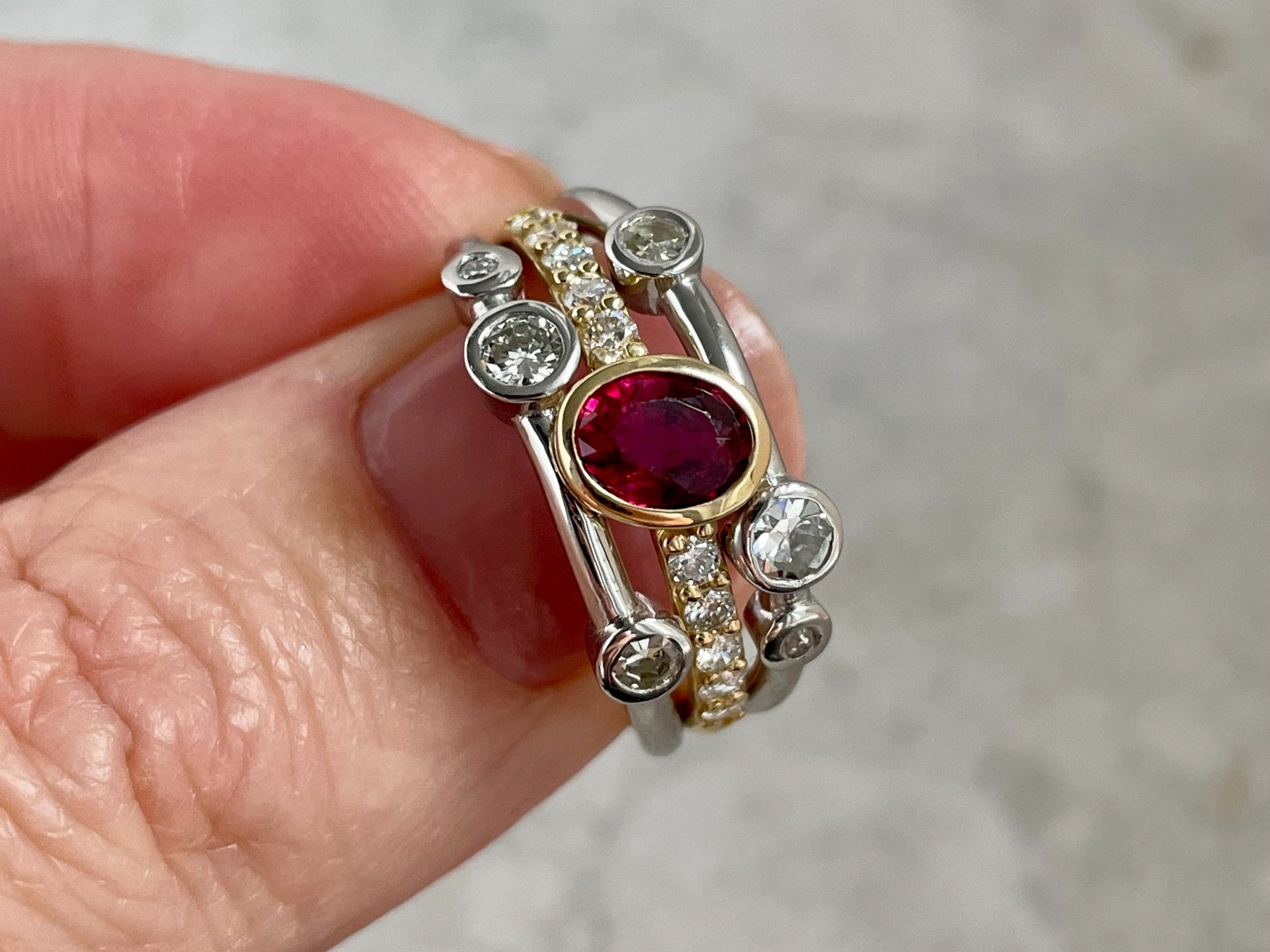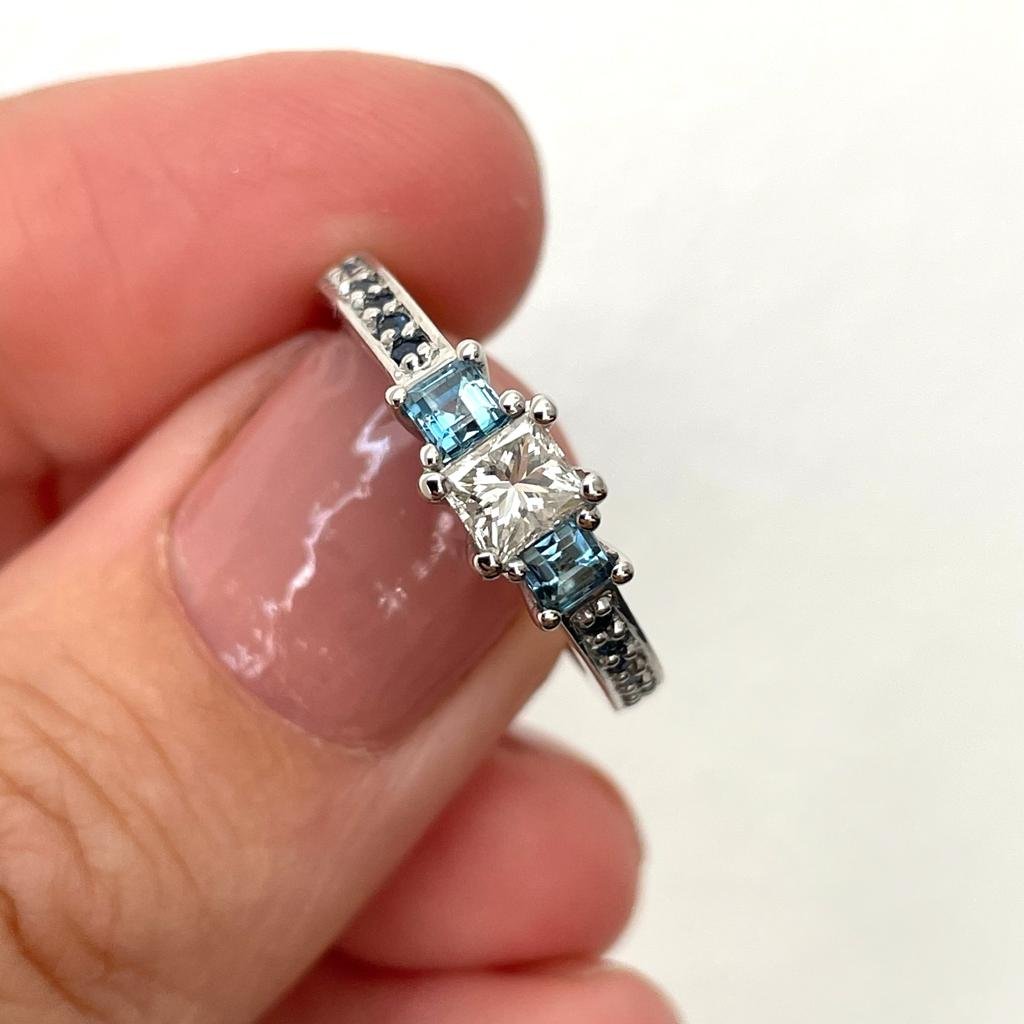A Comprehensive Guide to Diamonds and Gemstones
Unveiling the World of Diamonds and Gemstones: A Comprehensive Guide to Sparkling Splendor
Beautiful Triple Band with a Cushion Cut Emerald and Brilliant Cut Diamonds
In the realm of precious gemstones, a vast array of dazzling options awaits those with an appreciation for natural beauty. Each gemstone possesses its own distinct characteristics and allure, making it a captivating choice for jewellery enthusiasts. In this comprehensive guide, we delve into the captivating world of diamonds and gemstones, exploring the unique qualities that set them apart. Join us on this journey as we uncover the enchanting characteristics and exceptional attributes of Sapphires, Emeralds, Diamonds, Rubies, Topaz, Tanzanite, and Tourmalines.
Sapphires
Corundum is the mineral species that includes both sapphire and ruby as varieties. Red corundum is known as ruby and all other coloured corundum (including colourless, or “white sapphire”) is sapphire, with blue being the most well-known. The Princess of Wales’ beautiful blue sapphire and diamond engagement ring, that once belonged to Princess Diana, is quite probably the most famous blue sapphire in the world just now.
Sapphires that are not blue are known as fancy sapphires, and come in a wide ad stunning spectrum of fabulous colour, including pink, orange, yellow, green, purple, and violet. In general terms, the more intense and uniform the colour is, the more valuable the stone.
Sapphire and Diamond Raindance-Inspired Ring.
Sapphires in a Variety of Stunning Colours
Emeralds
The colour green isn't for everyone, but whether you love it or not, it’s hard to dispute that emeralds are in a class of their own. Alongside diamonds, rubies, and sapphires, emeralds are regarded as one of the world's most precious and sought-after gemstones.
Emerald is made from the mineral beryl, coloured green by trace amounts of chromium and sometimes vanadium. Other gemstones made from beryl include aquamarine and morganite.
The oldest emeralds are around 2.97 billion years old and the first known emeralds were mined in Egypt around 1500 BC with Cleopatra being a documented fan. They have been coveted for centuries and celebrated for their vibrant colour. They have natural inclusions known as jardin, and an association with timeless elegance.
Emeralds, though incredibly beautiful are considered the least durable of the main four precious gemstones due to their susceptibility to chipping and cracking.
Fine-quality emeralds, especially those with vivid colour, high clarity, and exceptional size, can be incredibly rare and valuable. A top-class quality emerald can be worth more than a diamond of the same carat weight.
Diamonds:
Diamonds are the earth’s hardest substance and the only gemstones made of pure carbon.
Formed billions of years ago around 100 miles below the Earth’s surface, diamonds are brought near the surface by volcanic activity.
Diamonds are universally adored, steeped in symbolism and revered for their brilliance, clarity, and rarity. They are usually assessed using the famous 4Cs—cut, clarity, colour, and carat weight.
Diamonds are graded in colour from D (colourless) to V and usually decrease in value as the colour becomes more obvious. Just the opposite happens with fancy colour diamonds: Their value generally increases with the strength and purity of the colour. Large, vivid fancy colour diamonds are extremely rare and very valuable. However, many fancy diamond colours are muted rather than pure and strong.
Only 1 in 10,000 diamonds is a fancy, vivid colour.
In April 2017, the pink star diamond weighing 97.60 carats sold for $71.2 million - becoming the most expensive gemstone ever auctioned.
When it comes to fancy colour diamonds, the most valuable hues are pink, blue, and green. Slight colour differences can have an impact on desirability and value.
Diamonds possess a remarkable ability to refract and reflect light, resulting in a dazzling play of colours and an unmistakable sparkle. This captivating optical quality, coupled with their rarity, makes diamonds not just a symbol of love and luxury but also an embodiment of elegance and everlasting beauty.
An Impressive 8.41ct Natural Fancy, Intense Yellow Diamond
Stunning 4.84ct E-Colour, VS1 Clarity, Oval Diamond
Rubies:
Rubies, like sapphires are made from corundum and the name ‘Ruby’ comes from the Latin name for red, ruber. The brightness of the red colour of chrome-rich rubies is caused by their fluorescence and the effect can be spectacular when exposed to ultra-violet radiation in the dark. With their intense red hue radiating a fiery essence, rubies personify passion, love, and strength.
These mesmerizing gemstones are renowned for their exceptional hardness, measuring 9 on Moh’s scale, serving as a symbol of durability and resilience. The enchantment of rubies lies in their captivating symbolism and their ability to mesmerize with their vibrant red glow. They are often set alongside diamonds to show off their vibrant colour to perfection!
Fabulous Raindance-Inspired design on a Tapered Triple Band, Featuring a Beautiful Oval- Cut Ruby.
Topaz:
Topaz crystals have been held in high regard as gemstones from classical times and were fondly known as the ‘Golden Stone’ with it’s stunning tones ranging from pale yellow to a rich brown.
Topaz are now celebrated in a kaleidoscope of captivating colors, offering a dazzling array that spans from vibrant blues reminiscent of a clear summer sky to warm yellows and delicate pinks. Each hue possesses its own distinct charm and allure, making topaz a versatile gemstone that can suit a variety of personal styles and preferences.
What truly captures attention when it comes to topaz is its high refractive index and remarkable clarity, topaz exhibits an enchanting sparkle that effortlessly draws the gaze and illuminates any piece of jewelry it adorns.
Tanzanite:
Tanzanite is a member of the mineral family zoisite, which has long been known as an opaques ornamental mineral, often pink or green in colour.
As a relatively new addition to the gemstone world, the Tanzanite was discovered in the Usambara mountains of Tanzania in 1967 as a beautifully transparent blue gemstone with hints of purple, it caused a big stir in the gem world! Mined exclusively in Tanzania, this enchanting gemstone is cherished for its rarity and unique color-changing properties.
Tourmalines:
Offer the widest range of colours of all gemstones, from vivid pinks and greens to deep blues and vibrant yellows. These gemstones exhibit remarkable diversity due to the chemical composition of the stone. It is a borosilicate compound of different metals, which vary in proportions affecting the density, colour and overall appearance.
Tourmaline is a fairly hard gemstone (7 - 7.5 on Moh’s scale) which makes them suitable for most types of jewellery. The stone is very popular in many countries, and in China was often worn to symbolize Mandarin rank. It was also carved into introcate figures and statues and elaborate pieces were worn as pendants and buttons. Some carvings dating back to the 19th century can now fetch thousands of pounds at auction.
The world of diamonds and gemstones is a treasure trove of beauty, intrigue, and individuality. From the timeless elegance of diamonds to the captivating allure of sapphires, emeralds, rubies, topaz, tanzanite, and tourmalines, each gemstone has a story to tell and a unique charm to offer. Whether you seek a gemstone to reflect your personality, commemorate a special occasion, or simply marvel at nature's splendor, the possibilities are endless. Embrace the world of diamonds and gemstones, and let their sparkling splendour illuminate your journey through the realm of fine jewellery.











